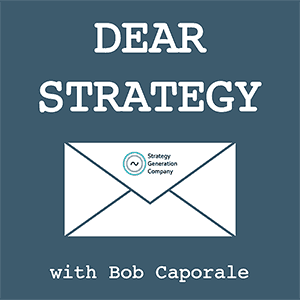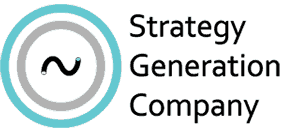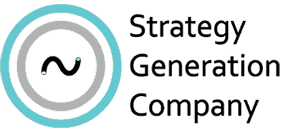Dear Strategy:
“How do you work/interact with your customers, so you can get ahead of their needs and bring about the desired results?”
Thankfully, we get a lot of questions on this show about gathering customer needs. I say “thankfully” because – well, we’re just coming off the Thanksgiving holiday here in the U.S. and I am, in fact, very appreciative of all the product and business managers who are attempting to put the needs of their customers above the needs of their companies. So, yes, as a customer and a consumer, I thank you.
With that said, and because this is a topic that rightfully seems to be getting more air time as of late, I have already provided some pretty specific guidance (see Episode 44 and Episode 66) with respect to the tools and techniques that you can use to gather customer feedback more effectively. So definitely be sure to give each of those links a click when you get a chance.
In this post, however (and so as not to be too repetitive), I wanted to venture into a slightly different aspect of this topic that I may not have covered too much before. And that is, analyzing your customers by simply making more time to visit with them.
Now, before you point me in the direction of your respective Sales teams, I’m not talking about visiting customers for the purpose of trying to sell things to them. No – what I’m talking about is spending more time talking to them about their problems, their issues, and their needs. And even beyond that, spending more time simply observing them in action.
I’ve been delivering workshops to corporate product management teams in some form or another for the past 6+ years. And, in nearly every class, I ask my audience how much time they’re spending out in the field, proactively visiting with their customers (not in relation to a sales call). Incredibly, the number comes back, on average, in the neighborhood of 5%. To put that in perspective, that equates to just 1 day per month. Now, compare that to a small business or an entrepreneur just getting started on Kickstarter. How much time do you think they spend?
Well, I can tell you that, for just over a year, I hosted another podcast called Making It Real, for which I interviewed 60 different entrepreneurs and small business owners about how they got their starts. And, although I didn’t always ask that same specific question, I would estimate (at least anecdotally) that the guests I interviewed spent approximately 50% or more of their time getting feedback, observations, and inputs from their respective customer bases. And, honestly, that would be a very conservative estimate.
Of course, none of this should be terribly surprising given the fact that almost every company starts out with a small number of employees and, with that, a relatively small number of internal needs. So, there’s really no place to focus except on the outside world. But as companies grow and scale, their internal demands also grow in proportion. So instead of being pulled outside their companies, employees start getting pulled inside their companies; and all of those internal demands start to become (at least by all appearances) more and more urgent. In other words, as soon as you bring investors and bosses and other employees into the mix, your priorities start to shift – and not always in a good way.
So, if you happen to work in one of those places, how would you go about fixing this bleak little dynamic?
Well, my official answer is simply to reprioritize your external demands above (or at least on par with) your internal demands. In other words – just start scheduling more proactive customer visits on your darn calendar!
“…as soon as you bring investors and bosses and other employees into the mix, your priorities start to shift – and not always in a good way.“
Honestly, I am amazed at how infrequently this is actually done. As good corporate citizens, we think nothing of putting monthly review meetings, weekly staff meetings, and just about every other type of meeting you can think of on our calendars – including sales meetings, tradeshows, and even offsite retreats. And most of us would never dream of missing even a small fraction of any of those events. But when it comes to proactive, non-sales-related customer visits, these all-important activities somehow seem to slip through the cracks. At best, we’ll do them “if we get a chance,” and, at worst, we’ll never do them at all. Either way, as a collective group, large companies just aren’t spending enough time truly getting to know their customers.
Psychologically, I’m sure there’s some reason that we’re so quick to gloss over the act of proactively gathering customer feedback. Maybe it’s because doing so won’t yield any type of immediate result. Or maybe there’s not quite enough downward importance being placed upon these activities from the tops of organizations. Honestly, I’m just not sure. But one thing is for certain – if you want to gather information about your customers, you have to spend time with them. And if you want to spend time with them, you need to make time to do it.
So, my message this week is an easy one. Go to your calendars and block 3 days in January to spend with your customers. Then, do it again in February, and again in March, and so on down the line. By the end of the year, you should have 36 or so days blocked to go out and gather customer feedback – through interviews, observation, or just plain old personal interaction. That’s still only 15% of your time, but it’s likely to be 3x more time than you’re spending on those activities today. And that’s going to give you 3x more information about your customers than you currently have today.
And that, no matter which way you slice, is worth a few extra days of your time.
Listen to the podcast episode
Dear Strategy: Episode 070

###
Are you interested in strategy workshops for your product, marketing, or business managers? If so, please be sure to visit Strategy Generation Company by clicking the link below:
 Bob Caporale is the founder of Strategy Generation Company, the author of Creative Strategy Generation and the host of the Dear Strategy podcast. You can learn more about his work by visiting bobcaporale.com.
Bob Caporale is the founder of Strategy Generation Company, the author of Creative Strategy Generation and the host of the Dear Strategy podcast. You can learn more about his work by visiting bobcaporale.com.






